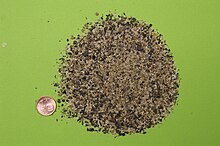Horn manure
Horn manure is manure obtained from crushed horn from cattle for slaughter. Usually for horn manure horns and hooves of cattle ground. Horn fertilizer has a neutral effect on the pH value of the soil , and due to its organic origin it has a high nitrogen content, the nitrogen content (N) predominates at 12% to 15%. K 2 O and P 2 O 5 are less than 1% by mass . The organic matter content is 85%, but fertilization with horn does not increase the organic matter content in the soil, or only slightly increases it, since the organic matter contained is easily degradable. The fertilizing effect of the nitrogen contained takes place in one to two weeks up to several months , depending on the soil temperature , moisture, aeration and the grain size of the chips. It is available in different grain sizes, so horn meal is easiest to absorb from the ground due to its small grain size (<1 mm) and therefore works the fastest, coarser horn meal (grain size 1–5 mm) is often used by hobby gardeners . Horn meal or horn shavings (> 5 mm) have a long- lasting effect .
Horn fertilizer was particularly popular in biodynamic agriculture in the 20th century. The traditional horn fertilizers in Germany had been largely replaced by synthetically produced nitrogen fertilizers (so-called artificial fertilizers). Organic farmers who are not allowed to use mineral nitrogen fertilizers are now increasingly using it again because horn is an organic, renewable raw material and, due to its slow interaction with the soil and nature, it is more soil-compatible than conventional artificial fertilizers. In a publication by the EU Commission, horn and hoof material is classified as safe with regard to BSE because it consists exclusively of dead tissue . It has not been conclusively clarified whether horn fertilizers can spread BSE pathogens. The only horn mill in Germany is in Ulm .
Just like animal horn products, human hair (hairdresser) and even sections of toenails or fingernails ( keratin ) can be used as nitrogen fertilizers with a nitrogen content of 12 to 14%.
Individual evidence
- ^ Helmut Zander: Anthroposophy in Germany. Vandenhoeck & Ruprecht, Göttingen 2007. P. 1581 f.
- ↑ Article 12 paragraph 1 e) of the Council Regulation (EC) No. 834/07 of June 28, 2007 on ecol. / Biol. Production and labeling of ecological / biol. Products etc.

